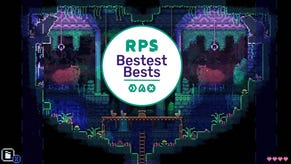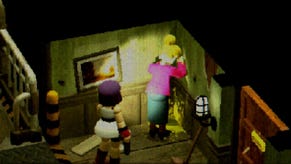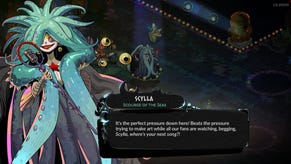Wot I Think: Sethian
The Future Question
Sethian [official site] came out, perhaps unwisely, in the midst of the annual November deluge. It’s a little niche - a single-screen mystery about typing commands into an alien computer to find out more about the extinct race behind the device. But the computer functions only in the local extraterrestrial tongue. As an xeno-archeologist out to save your career from ruin, it’s up to you to decipher and translate much of this language, a symbolic script that is inspired by Chinese, American Sign Language and other languages but also includes features which “have no real world counterpart.” At its heart is a central question: where did all the aliens go?
Of course, it doesn’t expect you to figure it all out yourself. Right-clicking opens your journal, which introduces some of the basic elements, including how it is read (top-to-bottom, right-to-left) and the importance of punctuation. “In Sethianese,” we are soon told, “most words can be nouns or verbs.” The placement of punctuation symbols determines which is which. This is the first mind-fizzler of the game. Later, right-clicking on any symbol will bring you to its corresponding page in your home-brewed dictionary, written in your character’s homely, just-about-legible scrawl. It usually lists how the symbol can be used as a noun or a verb. For example, there is a symbol meaning “to leave” but when used as a noun it means “stasis”. The symbol for “to be complete” also means “all” or “everything”.
It has other quirks. There is no word for “where” so you have to jam together the symbols for “what” and “place”. Similarly, to ask “who” you need to slap together the hexagonal “what” and a ‘O’ symbol that simply means any kind of entity or person. Many interrogative words – do, is, are – have to be replaced by a single triangular symbol, followed by a kind of colon – a prefix denoting a direct question.
All this can leave you feeling like a right clever clogs, despite the game more or less leading you directly to the answer (but more on this soon). For example, the protagonist's notes translated one sentence as “rise and fall”. From the dictionary I could see what all the symbols in this phrase meant in their literal form, except for one. To me it read: “High time, something time”. I knew the whole thing roughly meant “rise and fall”, so it made sense that the undocumented symbol meant “low”. When I saw the same “low” symbol next to a “heart” symbol, I understood that, together with the context of the sentence, “low heart” must mean “sadness”. The beginning of the game is full of small jigsaw pieces of language like this, it’s a puzzle that is almost algebraic – you take the things you know and build it up around the things you don’t.
The downside comes in the form of those handwritten notes. After you punch in a question by clicking on all the necessary symbols, new pages will be added in your journal, always translating whatever answer you received and suggesting the next question to ask. I say “suggesting” but really it almost always outright tells you what you need to input to reach the “next step”. This makes it feel very hand-holdy. The game has an irreconcilable problem here. Because without many of the translations you receive it would be far too tough to figure out, and without input suggestions the game’s AI would easily become a frustrating command driven interface. But including all those helpful hints and suggestions also ruins most of the challenge.
Part of me wishes it had made you more directly reliant on your reference material, rather than drip-feeding you a guiding scrawl done by your own disembodied character. One of the greatest forgotten pleasures of gaming is using a notepad to scribble clues down as you play – Her Story offers you that joy but Sethian seems afraid to follow through on the idea, instead writing down all the clues for you. For a game with a running motif of faith, it could afford to have more in its audience. It came to the point where, whenever I got an answer from the computer, I refused to check the journal’s scribbled translation until clicking each individual word with a right-click, constructing the response for myself - because that's where the fun is, where the puzzle is. Only then would I consult the new journal entry which would always break it down on the player’s behalf, sometimes in a different way I had interpreted it, leaving me frustrated that there was effectively a canon translation.
You can finish it in a couple of hours, insofar as you can reach the story’s ending with the right questions and following obediently along the path. But for lingua-completionists there is extra joy, because even after this there are pages and pages of symbols left unexplained and undocumented. The real aim, you realise, isn’t to reach the story's climax but to create the first Sethian-English Dictionary by probing the computer continuously. This is both the game’s novelty and problem. Interactive fiction that relies on a parser can be haphazard and inaccessible enough when it is written in plain English. Now apply that same flaw to a parser that takes its commands in a symbolic alien language, a language in which you’re not even comfortable with all the rules of punctuation. Simply put, it is a game in which you will see this phrase a lot:
That is the computer saying “I do not understand”. There are some other variations of this. “I can’t say anymore about that” or “I don’t know”. Inputting wrongly-framed question after wrongly-framed question leads to a lot of this, with a single mislaid symbol enough to make your query unanswerable. It doesn’t help that the interface means you have to flip back and forth through the library of symbols to repeat the same thing (although there are buttons which step back and forth through previous messages). It often feels not like interrogating a strange, possibly unfriendly alien machine, but like playing interactive fiction in Japanese using only a pamphlet titled “Kanji for Dummies”.
Despite those problems, I find myself deeply impressed by it all. It is an undeniably clever creation. And the moments when you ignore the guiding hand and think through the symbols yourself can be hugely satisfying in a self-indulgently cerebral way. You start to translate things in your head on sight, a kind of miniature version of subordinate bilingualism. For many phrases, I couldn’t help but think of them with a Native American tone. For instance, the journal always referred to an event which it translated as the “ascension” or sometimes the “great ascension” but I preferred the broken way of saying this, symbol by symbol, and always read it internally as the “High-go” or the “Big High-go”. It just sounded better that way. Even the proper noun for "Sethian" could be translated literally as the "Future Question" - a vague name that takes on new significance once you reach the end of the story.
The way the story is told, too, the attitude of the machine and the way it speaks to you is well-suited to the atmosphere of the unknown. At one point you see a symbol, a straight vertical line, followed by a type of punctuation, basically a colon on its belly. When you look this pair up in your dictionary, you get two conflicting translations of what it means from two fictional authors who have previously studied the language. One of them – Otska - says it is a request, meaning “please: do X”. The other – Bhatguhar - insists that these symbols signify a command, meaning “order: do X”. This invokes a tone of unease, not through the content of the computer’s responses but through how such content might be interpreted. When the computer says "|: high-go" is it saying: “please ascend”? Or is it saying “I order you to ascend”? A tonally ambiguous message that puts you on edge precisely because it leaves you wondering how the machine is thinking, how it is designed, and what in physical terms does the “Great High-go” even involve? I once asked the computer: “are you good?” and it said that the question was “not place” which translates as “irrelevant”.
If you ask me “is Sethian any good?” you’re really asking about two distinct things: the language, which is an incredibly intelligent and creative work of world-building. And the game, which is usable, workable, but ultimately wounded by its reliance on what is essentially parser-based interactive fiction.
However, I’m very glad it exists. If it is simply interactive fiction, it’s a wonderfully inventive take on it. I love its symbology and mystery, its citations of fictitious scholars with their disagreements and lapses, the way you can interpret a culture as deeply pious or vaguely threatening through nothing but squiggles assigned meaning – its exactly the kind of story that makes me think that if Borges was alive today he’d be fascinated by videogames. Or at least, the good ones. And despite those parser faults and UI problems, many of which feel sadly unavoidable to create a game in this form, I feel like Sethian has earned that description. It’s one of the good ones. Or, as a Sethian might say:
You can get Sethian on itch.io for $5 or on Steam for £3.99/$4.99



















